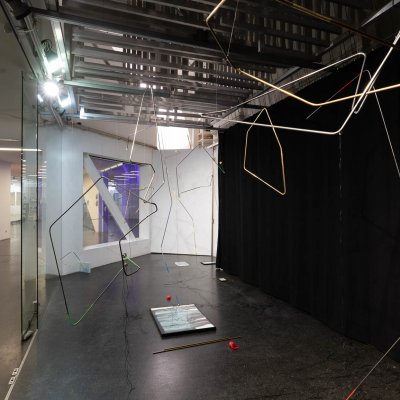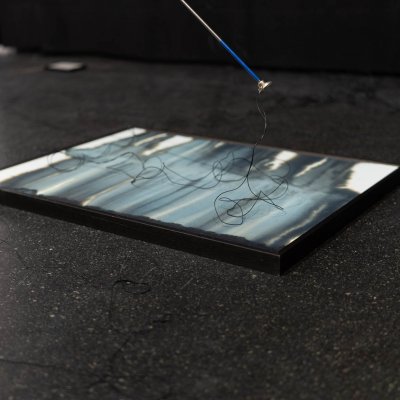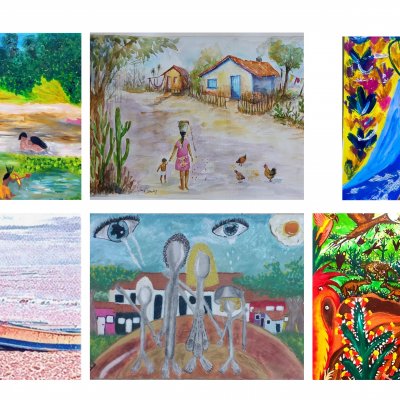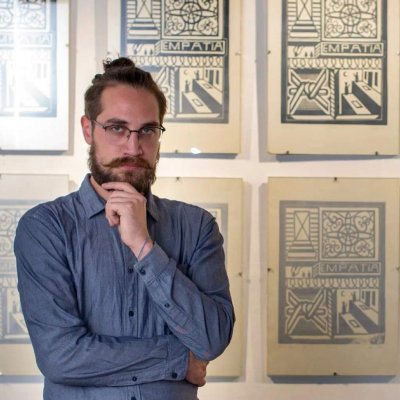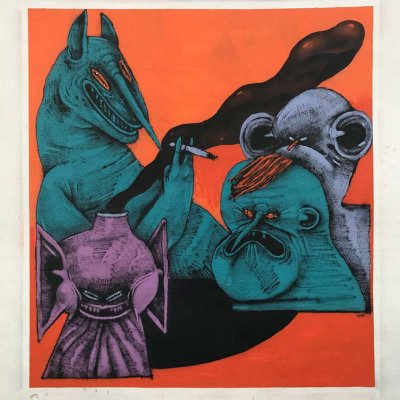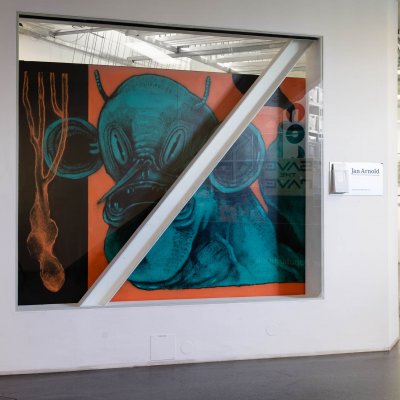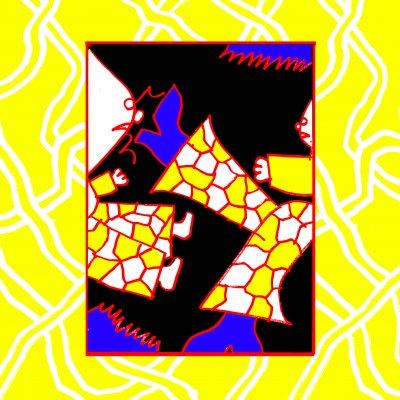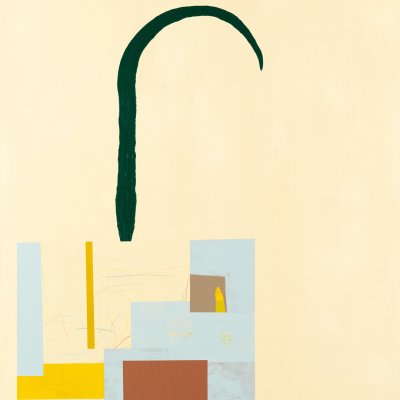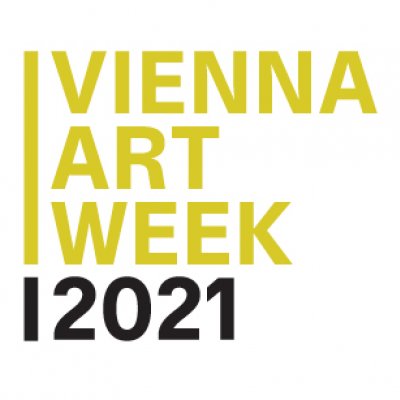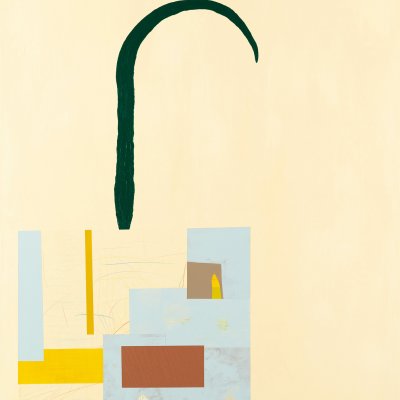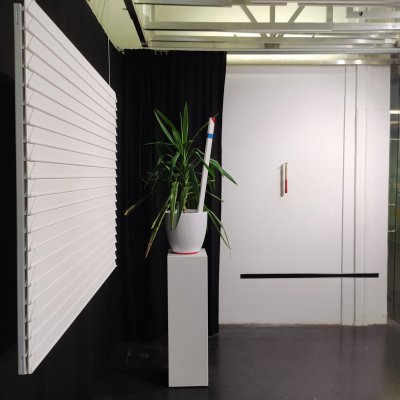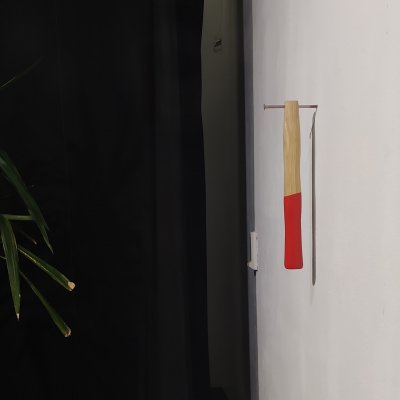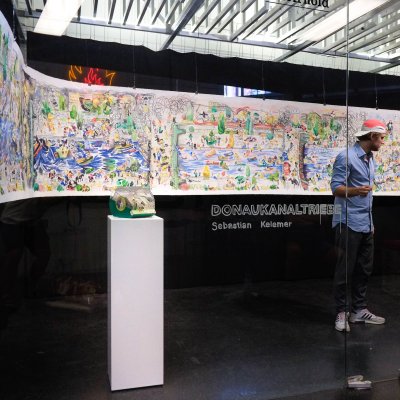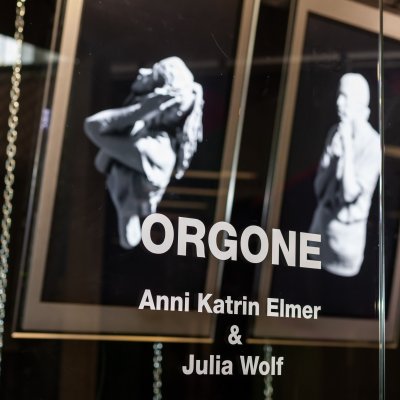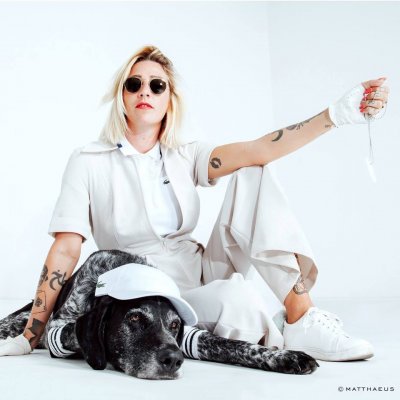Wir freuen uns im Dezember die Künstlerinnen Jumumonster und Gamze im Wiener MuseumsQuartier willkommen zu heissen. Es wird im Zuge ihres Aufenthalts eine kleine Präsentation in der Jan Arnold Gallery geben.
home
Q21 Artist in Residence - Jumumonster & Gamze
We are happy to welcome the artists Jumumonster and Gamze to the MuseumsQuartier in Vienna in December. In the course of their stay there will be a small presentation in the Jan Arnold Gallery.
I have a dream, I’m coming back.
Exhibition by Jurena Muñoz Lagunas and Gamze Yalcin
December is the month of closing of the year and at the same time welcoming a new year.
Best timing for both artists to catch a breath for a moment, close and open new pages after a long year, finding new joys in their creations here in Vienna. During December, residence artists Jurena and Gamze explore possibilities to create different dialogues between their work and the studio’s framework inside the MuseumsQuartier with all the museums and cultural institutions forming one of the biggest cultural complexes in the world.
“I have a dream, I’m coming back” is the result of both artists’ artistic experimentation, cultivating differences, similarities and shared influences in a cohesive use of the space.
Jurena “Jumu” (1990, Hannover) is an artist based in Berlin.
Jumu’s world is a connection between humanity, empowered women, the spirit world, and nature.
Paintings, masks, ceramics, costumes, murals and more, Jurena has a wide, perpetual multidisciplinary exploration in her art practice. Her work is characterized by a colorful palette, bold shapes and her Latin American roots.
Gamze Yalcin
Gamze (1987, Istanbul) is an artist based in Berlin.
Gamze’s work is an ongoing study of landscape and color. Her artistic practice includes painting and color search. It evolves from the dream/landscape paradox, shaping unknown/timeless spaces and creating semi-abstract compositions in the form of stories.
Both artist were invited by Sebastian Schager / Artis.Love / Streetartpassage for the Q21 Artist-in-Residence program.
Juliana Herrero - FUGA N22
FUGA N22 entfaltet sich durch feine Klänge und Linien zu immersiven Welten, deren Ursprung in den tatsächlichen Gegebenheiten unserer Umwelt liegt, in ihrem flüchtigen Moment des Erscheinens und Verschwindens. Inspiriert von John Cages Ideen und seinen imaginären Landschaften, erforscht dieses Werk von Juliana Herrero die visuelle, dritte und vierte Dimension (Raum und Zeit) der erlebten Musikalität weiter. Der Ausstellungsraum der Jan Arnold Gallery im MuseumsQuartier zeigt Messing- und Stahlassemblagen, Klang- und Mischtechniken sowie experimentelle Entwürfe. Einmal die Wurzeln von Klangquellen beschreibend, dann zu einer Schleife werdend, erwecken sie Erinnerungsfragmente durch Klang zum Leben. Das Buntglasfenster dehnt die osmotischen Grenzen zwischen Natur und Künstlichkeit, der Geschwindigkeit des urbanen Rhythmus und der Ruhe von Orten aus, die mit ihren Klanglandschaften Erinnerungen an andere Orte hervorrufen.
Es gibt offene und geschlossene Linien, flache und dreidimensionale, Multiplizitäten und Dichotomien, die Dialoge mit der Multiplizität erproben und den Raum in der Zeit wie eine offene Partitur artikulieren. Text, Klangsequenzen und Stille als poetischer Ansatz der Interpunktion zur Überbrückung zeitlicher Distanzen werden in intermittierenden Frequenzen kombiniert. Ein Kontrapunkt von Klängen zwischen natürlichen Arten ist deutlich hörbar. Diese Klangsequenzen, die den Grundteppich bilden, sind eingefangene Aufnahmen der Umwelt und ferner Landschaften aus persönlichen Archiven und gefundenem Material multimedialen Ursprungs. Räumlich in zwei Schleifen über mehrere kleine Lautsprecher verteilt, verweist die Klangcollage auf das Hier und Jetzt, auf den Moment, in dem der:die Wahrnehmende sie sich zu eigen macht.
Performance
Duba Duba /// Liliana Arreola, Juliana Herrero: über die Komposition "Equilibrio" Fragment aus „Cantos de la Tierra" von Galia Mirscha (Text und Musik). Fragmente am Klavier von Barbara Probst, Sound Tepich Collage Archive Material (JH)
Mit der Stimmung und Didaktik der Musik ergeben sich Interventionen über den Klangteppich im Raum, indem Harmonics-Fragmente der Gitarre verwendet werden, und wir Fragen und Antworten spielen, die keine sind, sondern ein Gedicht. Wir stimmen und konstruieren mit unseren Körpern das lange A der runden Öffnung und das tiefe O der Schließung und wir dehnen das I, das U, wir ziehen mit unseren Armen an dem gebogenen E und so reisen wir durch Zeiträume, die das innere Kind in uns zurückbringen.
Juliana Herrero widmet sich 1:1 Rauminstallationen, Klanginstallationen, musikalischen Objekten, Architekturen von Atmosphären, Transpositionen als Synästhesie in Aquarell als experimentelle Cyanotypie und Interventionen in situ und live. Übergeordnet kann ihr künstlerisches Schaffen der Konzeptkunst zugeordnet werden.
Bildung: 1986-1992 INSA (heute IUPA) Tanz und Musik / Gral. Roca, R.N. (AR) /// 1994-2000 FADU, UBA Architektur / Buenos Aires (AR) //// 2002-2006 STÄDELSCHULE Staatliche Hochschule für Bildende Künste, Ffm: Konzeptionelles Entwerfen (Arch. Klasse) Prof. Ben van Berkel (Aufbaustudium 2004) und 2005-2006 Filmklasse Prof. Mark Leckey
Juliana Herrero wurde 1975 in Choele Choel, Río Negro, geboren. Sie studierte in Argentinien und Deutschland und entwickelte später ihre Arbeit über die Breitengrade hinweg. Derzeit arbeitet die Künstlerin zwischen Buenos Aires und Wien, wo sie auch seit 2006 lebt.
FUGA N22 unfolds through fine sounds and lines into immersive worlds whose origin is in actual realities of our environment, in their fleeting moment of appearance and disappearance. Inspired by John Cage's ideas and his imaginary landscapes, this work further explores the visual, third and fourth dimensions (space and time) of experienced musicality. Jan Arnold Gallery's showroom in the Passage of Q21 (MuseumsQuartier) features brass and steel assemblages, sound and mixed media, and experimental blueprints. Once describing the roots of sound sources, then becoming a loop, they bring fragments of memory to life through sound. The stained glass window stretches the osmotic boundaries between nature and artificiality, the speed of urban rhythm and the quiet of places that evoke memories of other places with their soundscapes. There are open and closed lines, flat and three-dimensional, multiplicities and dichotomies, testing dialogues with multiplicity and articulating space in time like an open score. Text, sound sequences, and silence as a poetic approach to punctuation to bridge temporal distances are combined in intermittent frequencies. A counterpoint of sounds between natural species is clearly audible. These sound sequences, which form the basic tapestry, are captured recordings of the environment and distant landscapes from personal archives and found material of multimedia origin. Spatially distributed in two loops over several small speakers, the sound collage refers to the here and now, to the very moment when the one who perceives it makes it his own.
Performance
Duba Duba /// Liliana Arreola, Juliana Herrero: on the composition "Equilibrio" fragment from "Cantos de la Tierra" by Galia Mirscha (text and music).
Fragments on the piano by Barbara Probst, Sound Tepich Collage Archive Material (JH).
With the mood and didactics of the music, interventions arise through the sound tapestry in the space, using harmonics fragments of the guitar, and we play questions and answers that are not, but a poem. We tune and construct with our bodies the long A of the round opening and the deep O of the closing and we stretch the I, the U, we pull with our arms the curved E and so we travel through spaces of time that bring back the inner child in us.
Juliana Herrero is dedicated to 1:1 spatial installations, sound installations, musical objects, architectures of atmospheres, transpositions as synesthesia in watercolor as experimental cyanotype and interventions in situ and live. Superordinately, her artistic work can be classified as conceptual art.
Education: 1986-1992 INSA (now IUPA) Dance and Music / Grail. Roca, R.N. (AR) /// 1994-2000 FADU, UBA Architecture / Buenos Aires (AR) //// 2002-2006 STÄDELSCHULE Staatliche Hochschule für Bildende Künste, Ffm: Conceptual Design (Arch. Class) Prof. Ben van Berkel (Postgraduate 2004) and 2005-2006 Film Class Prof. Mark Leckey
Juliana Herrero was born in 1975 in Choele Choel, Río Negro. She studied in Argentina and Germany and later developed her work across latitudes. Currently the artist works between Buenos Aires and Vienna, where she also lives since 2006.
Slow Wave III - bridging time windows
„Lass unsere Imagination fliegen. Dass wir die Ebene eingrenzen. Dass wir die Linie oder Kurve zeichnen, die den Wendepunkt vermeidet. Stellen wir uns vor, eine Hoffnung zu finden, die nach Wahrheit dürstet und Einblicke in die Flügel gewährt, die sich erheben. Wir wissen, dass Mutter Erde keinen Planeten "B" hat. Während sich die Wüsten ausdehnen, die Erwärmung in der Arktis zunimmt, der Permafrost schmilzt und wir über die Korallenriffe und den kostbarsten Stoff Wasser sprechen und von Delphinen, Kamelen, Liebesvögeln und Schmetterlingen träumen, befinden wir uns immer noch in diesem Impulskontinuum. Dazu gehören der Anstieg des Meeresspiegels und die Übersäuerung der Ozeane. Krankheiten, wirtschaftlicher Verlust, Migration von Menschen, Konflikte, Migration von anderen Lebewesen. Kinder wacht auf! Ihr seid die Welt, ihr seid die Zukunft. In Slow Wave fragen wir uns, ob wir Mikroerzählungen des betroffenen Gedächtnisses über das Leben auf der Erde und die Veränderungen der biologischen Vielfalt konstruieren können. Indem wir über dekoloniale Angelegenheiten der planetarischen Koexistenz nachdenken, glauben wir an poetische Formen des Eingreifens in die Realität, um Präsenz und Bewusstsein zu schaffen und unsere nahe Umgebung hier und dort zu aktivieren, wo wir sind, wo wir waren und wo wir sein werden."
SLOW WAVE präsentiert offene künstlerische interstitielle Begegnungen und reflektiert unsere aktuellen Produktionsweisen, die sich dem Klima im weitesten Sinne und der Zeit nach der Pandemie nähern. Das Konzept bezieht sich auf die Natur in ihrer offenen Weite und auf unsere physischen und virtuellen Umgebungen, in denen wir uns bewegen, Spuren hinterlassen und koexistieren. Dieses künstlerische Format übernimmt physische und virtuelle Räume, die sich von innen nach außen erweitern. Es entfaltet eine Sammlung künstlerischer Positionen innerhalb von Videobeiträgen in einem kollektiven Format, das die Medien zu einer installativen und performativen Praxis erweitert. Das Programm ist von seiner Konzeption her offen für eine Vielfalt künstlerischer Genres und Zukünfte und fördert die Gleichstellung der Geschlechter.
--
Artists / Künstler*innen
Milagros Arias, Aylen Almendra, Liliana Arreola, Eunice Artur, Stella Bach, German Bormann, Maria Bussmann, Natalia Forcada, Pablo Chiereghin, Ilse Chlan, Casaluce Geiger, Aldo Giannotti, Thomas Grill, Andrea Habith, Juliana Herrero, Federico Kehm, Si.Si. Klocker, Las Hijas de Israel, Lian Loke, Raisa Maudit, Sissa Micheli, Carmen Omonte Miraval, David Mollin, Karin Maria Pfeifer, Ana Rascovsky, Jutta Ravenna, Dagmar Reinhardt, Agnes Rossa, Sylvia Schultes, Nita Tandon, Christoph Urwalek, Linda Velásquez, Jose Carlos Velayarse (Jode), Salomé Voegelin, Christina Werner, Stefanie Wuschitz, Gerald Zahn, Sula Zimmerberger.
--
Expanded Programme / Erweitertes Programm
Site specific Intervention:
antenna debris /// Thomas Grill, Juliana Herrero
Performances:
IMPROVISATIONS IN THE SPACE
Thomas Grill
Linda Velásquez
Jose Carlos Velayarse (Jode)
“Imagine to narrow down the plane. Imagine to draw the line or curve that avoids the point of inflection. Imagine finding a hope thirsty for truth that allows glimpses of the wings that soar. We know that Mother Earth has no Planet “b”. While deserts are expanding, increased warming in the arctic, melting permafrost, and we speak about the coral reefs, of the most precious substance water and we dream of dolphins, camels, love birds and butterflies, -we are still in this momentum continuum. This includes sea level rise and more acidic oceans. Disease, economic loss, human migration, conflict, other beings’ migration. Children wake up! You are the world, you are the future.
In Slow Wave, we wonder whether we can construct micro narratives of the affected memory concerning life in Earth and changes on bio-diversity.
Thinking about decolonial matters of planetary coexistence we believe in poetical forms of intervening reality to create presence, consciousness and to activate our near surroundings here and there where we are, we were, we will be.“
SLOW WAVE presents open artistic interstitial encounters, reflecting on our current ways of production approaching climate on a broad sense and the post-pandemic era. The concept relates to nature on its open wide and to our physical and virtual environments where we transit, leave traces and co-exist. This artistic format takes over physical and virtual spaces expanding from the interior to the outside. It unfolds a collection of artistic positions within video contributions in a collective format expanding the media into installative and performative praxis. The programme on its conception is open for a plurality of artistic genres and futures, fostering gender equality.
Dzvinya Podlyashetska
We continue our Open Studio format to support Ukrainian artists with artist Dzvinya Podlyashetska. The figurative painter will work inside MQ Vienna at the Jan Arnold Show Room and open her show with the created work on site.
In de(Pendências)
33 bildende brasilianische Künstler:innen fertigten exklusiv für das X. Brasilianische Kulturfestival Wien je 1 Werk an (Öl, Acryl, Aquarell, Zeichnung, Fotografie, Collage), mit ihrem individuellen Blick auf das unabhängige Brasilien:
André Renaud, Ben Barr, Denise Lima, Di Miranda, Dson Pereira, Duda Clementino, Edna Carla Stradioto, Eliana Engler, Fábio Sampaio, Fernanda Carvalho, Gildecio Costaeira, Gustavo Bissoli, Helen Wolf, Jean Lima, Jeannine Krischke , Jessica Dantas, Karol Coelho, Kerly Steinbach, Kim Ferreira, Lemuel Gandara, Lúcia Guaspari, Mara Rúbia Colli, Maria Dutra, Mário Soares, Patrícia Pinheiro, R.F. Bongarten, Randes Silva, Rejane Wagner, Revolue, Rosangela Scheithauer, Sonia Camacho, Telma Levy, Ticiana Parada.
Kuratorin: Vanessa Noronha Tölle
Musikalische Untermalung mit Hamilton Luduvice
Das Brasilianische Kulturfestival Wien steht 2022 unter dem Motto „200 Jahre Unabhängigkeit Brasiliens“. Betont wird dabei die Rolle von Kaiserin Leopoldina (der österreichischen Erzherzogin Maria Leopoldine Josepha Carolina, verheiratet mit dem portugiesischen Kronprinzen und späteren Kaiser von Brasilien, Pedro I.), die entscheidend daran beteiligt war, dass es am 7. September 1822 zur Loslösung der Kolonie Brasilien von Portugal kam.
33 Brazilian visual artists created exclusively for the X. Brazilian Cultural Festival Vienna one art work each (oil, acrylic, watercolor, drawing, photography, collage), with their individual view of the independent Brazil:
André Renaud, Ben Barr, Denise Lima, Di Miranda, Dson Pereira, Duda Clementino, Edna Carla Stradioto, Eliana Engler, Fábio Sampaio, Fernanda Carvalho, Gildecio Costaeira, Gustavo Bissoli, Helen Wolf, Jean Lima, Jeannine Krischke , Jessica Dantas, Karol Coelho, Kerly Steinbach, Kim Ferreira, Lemuel Gandara, Lúcia Guaspari, Mara Rúbia Colli, Maria Dutra, Mário Soares, Patrícia Pinheiro, R.F. Bongarten, Randes Silva, Rejane Wagner, Revolue, Rosangela Scheithauer, Sonia Camacho, Telma Levy, Ticiana Parada.
Curator: Vanessa Noronha Tölle
Music by Hamilton Luduvice
In 2022, the Brazilian Cultural Festival Vienna will be held under the motto "200 Years of Brazilian Independence". Emphasis will be placed on the role of Empress Leopoldina (the Austrian Archduchess Maria Leopoldine Josepha Carolina, married to the Portuguese Crown Prince and later Emperor of Brazil, Pedro I), who played a decisive role in ensuring that the colony of Brazil broke away from Portugal on September 7, 1822.
Danya Kovach
Der Ukrainische Künstler Danya Kovach wird im August 2022 die Jan Arnold Gallery als temporäres Studio für sein künstlerisches Schaffen nutzen.
Kovach wird sich in den Zeitraum mit einer seiner bereits bestehenden Werkserien beschäftigen und im Prozess die Rolle eines wenig geachteten Objekt in eine semantisch umstrukturierte Bildsprache übersetzen. Er macht ein triviales Objekt zu seinem Werkzeug, welches im normalen Leben täglich im wahrsten Sinne des Wortes mit Füßen getreten wird - Der Fußabstreifer. In einer Seriellen Anordnung werden Abdrücke der Gummimatten zum ganzen vervollständigt und auf Leinwand gebracht. Im Prozess entsteht ein mehrfarbiger Monoprint welche nach der Fertigstellung aufgespannt und von der Horizontalen in die Vertikale überführ wird. Ein Bruch mit der grundlegenden Funktion des Objekts soll dessen Rolle als immer anwesender Zeuge an offenen, unerwünschten oder nötigen Schwellen soziokulturell erzeugter Räume zum Diskurs führen. In der langjährigen Werkserie wurden beispielsweise Fußabstreifer von Polizeistationen, Institutionen an Landesgrenzen oder Kirchen zum Werkzeug des Künstlers transformiert, welche sich nach ihrer Benutzung, rapportartig gereiht, als Abdrücke dieser Realitäten in einer meist versperrend wirkenden, gitterartigen Struktur manifestieren. Diese Ästhetik wird gebrochen, da diese mit verwaschenen aber sehr Bunt gehaltenen Landschaftsdarstellungen in derem Hintergrund auf dem Bildmedium zusammengezogen wird.
In Open Studio in der Jan Arnold Gallery wird eine Großformatige Malerei entstehen, welche den gesamten Schauraum in Anspruch nimmt (2x6m). Das zentrale Werk der Ausstellung stellt mit Hilfe von in Wien gesammelten Fußmatten einen direkten Bezug zum Ort der Entstehung her. Die Fußmatten werden nach der Entlehnung ihren eigentlichen Zweck rücküberführt und finden ihren Platz wieder da, wo sich Freunde begrüßen, Häftlinge gestoßen oder Türen verschlossen bleiben.
Danya Kovacs ist 1992 in in Zaporizhya, Ukraine geboren, lebt und arbeitet, solange nicht auf der Flucht in Liviv und Uzhhorod. Schwerpunkte seiner Arbeit sind Grafik, Malerei, Installation und Performance. Der Künstler Stammt aus einer Familie von Kunstschaffenden, wobei die Teilnahme seines Bruders als Vertreter der Ukraine and er Biennale in Venedig besonders hervorzuheben ist.
Ausbildung: Uzhhorod Children's School of Arts unter Emma Levadskoi. Member of the "Maly Louvre" children's and youth art association; Adalbert Erdely College of Arts, department of painting; Lviv National Academy of Arts, department (sacred art); School of Art performance: Przemysław Kwiek 2014, Janusz Baldyga 2016, Jürgen Fritz 2018.
Ukrainian artist Danya Kovach will use the Jan Arnold Gallery as a temporary studio for his artistic work in August 2022.
During the period Kovach will deal with one of his already existing series of works and in the process translate the role of a little respected object into a semantically restructured visual language. He makes a trivial object his tool, which in normal life is literally trampled on every day - the entrance matting. In a serial arrangement imprints of the rubber mats are combined and put on canvas. In the process, a multicolored mono-print is created, which after completion is stretched and transferred from the horizontal to the vertical. A break with the basic function of the object is intended to bring its role as an ever-present witness to discourse at open, undesirable or necessary thresholds of socioculturally generated spaces. In the long-term series of works, for example, entrance matting of police stations, institutions at national borders or churches were transformed into the artist's tools, which after their use, lined up in a rapport-like manner, manifest themselves as imprints of these realities in a mostly obstructive, grid-like structure. This aesthetic is broken up, as it is drawn together with washed-out but very colorful landscape depictions in the background on the image medium.
In Open Studio in the Jan Arnold Gallery, a large-format painting will be created, which will take up the entire showroom (2x6m). The central work of the exhibition establishes a direct link to the place of its creation with the help of doormats collected in Vienna. After being borrowed, the doormats are returned to their original purpose and find their place again where friends greet each other, prisoners bump into each other or doors remain locked.
Danya Kovacs was born in 1992 in Zaporizhya, Ukraine, lives and works, as long as not forced to leave his home in Liviv and Uzhhorod. His work focuses on graphics, painting, installation and performance. The artist comes from a family of artists, and his brother's participation as a representative of Ukraine at the Venice Biennale is particularly noteworthy.
Education: Uzhhorod Children's School of Arts under Emma Levadskoi. Member of the "Maly Louvre" children's and youth art association; Adalbert Erdely College of Arts, department of painting; Lviv National Academy of Arts, department (sacred art); School of Art performance: Przemysław Kwiek 2014, Janusz Baldyga 2016, Jürgen Fritz 2018.
Hudo - Open Studio
Im Juni heisst die Streetartpassage den Künstler HUDO aus Kiew als Artist in Residence in Zusammenarbeit mit dem Q21 im MQ Wien willkommen. Der Künstler wird zwei Wochen die Türen des Schauraums Jan Arnold öffnen und vor Ort malen. Wir freuen uns auch auf einen Beitrag für den Liftturm oder eine Wand an der Streetartpassage sowie einen potentiellen Druck mit LEAP - Limited Edition Art Prints.
In June, Streetartpassage welcomes the artist HUDO from Kiev as artist in residence in collaboration with Q21 at MQ Vienna. The artist will open the doors of the showroom Jan Arnold for two weeks and paint on site. We are also looking forward to a contribution for the lift tower or a wall at the Streetartpassage as well as a potential print with LEAP - Limited Edition Art Prints.
"I resorted to drawing back in 2007 as to a means of rehabilitation after a stroke. Eventually, it has grown into a medium for expression. Sticking to burning social issues and social thriller esthetics, I take what disturbs me and make a drawing out of it. I also reinterpret medieval engravings I am inspired by." Hudo
Burnbjoern - Fried Liver
The decision to leave this flesh prison behind had been made many years ago, but only now the day has come. I´m taking off the gross suit, peeling off the last pieces of tissue and fat, till my skeleton is clean. I like how the shiny bones reflect the sun, now I´m hopping on my horse and riding towards spam wasteland.
Ps: I kept my liver as a souvenir.
Burnbjoern made a book once.
Burnbjoern pretends to be busy but he is not.
Burnbjoern hates to draw.
Burnbjoern likes collage.
Burnbjoern is his real name.
Burnbjoern stopped listening to music.
Burnbjoern lives and works in Vienna.
Burnbjoern plans to eat more sandwiches.
Hubert Hasler - #OVERRUN+
Hubert Hasler fokussiert in seinem Projekt #OVERRUN+ auf aktuelle Schlagworte wie Überfremdung, Vermischung, Vertreibung, Endemie und Neobiota. Er bespricht Analogien von Pflanzen und Menschen, die unseren Kontinent seit Jahrhunderten beeinflussen und mit uns besiedeln. Die allegorische Darstellung von Neophyten führt nationale Gedanken ad absurdum.
Die Präsentation seiner neuesten Arbeit, Der nackte Pfau, legt ziemlich schnell die Parallelen zu Big Men nahe, die gerade die Welt in Chaos und Verwüstung stürzen. Die Selbstüberschätzung und die toxisch aggressive Männlichkeit im politischen Kontext wird ebenso thematisiert wie der Irrglaube und die Klassifizierung von Pflanzen und Menschen.
Unter Neophyten werden Pflanzen verstanden, die direkt oder indirekt, bewusst oder unbewusst vom Menschen nach 1492, dem Jahr der Entdeckung Amerikas durch Christoph Kolumbus, in Gebiete eingeführt wurden, in denen sie natürlicherweise nicht vorkamen. Experten gehen davon aus, dass in den letzten 500 Jahren rund 800 nicht heimische Tier- und Pflanzenarten vom Menschen eingeschleppt wurden. Heute wird die Verbreitung von Samen aus verschiedenen Gründen unterstützt, u.a. Güterverkehr und Reiseerleichterungen der globalen Zeit, aber auch aus wirtschaftlichen Gründen der Austausch verhindert. Es gibt auch Schwarzmärkte für Samen in USA und Canada, weil Firmen wie Monsanto es verhindern, dass gutes Saatgut weitergegeben wird.
Bei Pflanzen nimmt man an, dass sie nach 3 Generationen als etabliert einzustufen sind. Das ist der Fall, wenn sie sich ohne Hilfe in der neuen Umwelt reproduzieren können und überleben lernten.
Am Beispiel der Kartoffel, die in vielen Ländern der Erde zum Grundnahrungsmittel generierte, können wir den Prozess der Adaptierung beobachten. Ende des 16. Jahrhunderts wird dokumentarisch der Anbau der Kartoffel in Irland und England festgehalten. Es ist auch sicher, dass ab 1600 die meisten europäischen Botaniker Kartoffelpflanzen als kostbare Rarität in den eigenen Gärten züchteten. Es dauerte weitere Generationen, bis die Kartoffel von der Zierpflanze zum Nahrungsmittel transformierte. In Österreich war die Kartoffel auf der Agenda von Maria Theresia, trotzdem sollte es noch bis zu den Napoleonischen Kriegen an der Wende vom 18. Ins 19. Jahrhundert dauern, bis die Kartoffel in Österreich populär wurde. Ein langer steiniger Weg um heimisch zu werden.
Als Bedingung für Menschen mit Migrationshintergrund oder Flüchtlingen sich zugehörig nennen zu dürfen gelten in Deutschland und Österreich die Geburt von mindestens 2 Generationen, nicht Reproduktion oder Überleben. Der Heimatbegriff hat sich in den letzten Jahrzehnten auf konträre Arten verändert. Im Deutschen Wörterbuch der Brüder Grimm wurde Heimat 1877 als „das Land oder auch nur der Landstrich, in dem man geboren ist oder bleibenden Aufenthalt hat“. Das Wort war bis zur Mitte des 19. Jahrhunderts ein nüchternes Wort, welches im juristischen und geographischen Sinne gebraucht wurde.
Heute wird dem Begriff Heimat mittels politisch, kleingeistigen Nationalismus gefrönt, andererseits sehen die jungen Menschen, ab den Millenials, die globale Welt als ihre Heimat an.
Migranten beziehungsweise Immigranten, je nach Perspektive, sind Menschen die ihr Geburtsland oder vorübergehendes Heimatland aus diversen Gründen verlassen. Flüchtlinge sind Menschen, die aus Kriegsgründen, Umweltveränderungen und Armut ihre Heimat verlassen müssen.
Hubert Hasler zeigt mit seiner Neophyten Installations Serie #overrun + die Schönheit der Eindringlinge, aber auch die Verwunderung darüber, dass bekannte Pflanzen oft nicht aus unserem Lebensraum stammen.
Die von der westlichen Welt hauptsächlich verursachte Erderwärmung wird uns in Europa nicht nur völlig andere Pflanzen aufzwingen, sondern auch vermehrt Menschen aus dem trockenen Süden oder überfluteten Küstengebieten zu uns bringen. Evolution ist Adaption.
Von seiner Reise nach Georgien 2021 brachte Hubert Hasler Samen des Riesenbärenklau mit.
Dieser war 1890 mit den Botanikern Carlo Pietro Sommer und Èmile Levier nach Europa gekommen und etablierte sich schnell als beliebte Zierpflanze. Der Riesenbärenklau wurde von Imkern sehr geschätzt und als Böschungsbefestigungspflanze eingesetzt. Anfang des 20. Jahrhunderts verwilderte er und breitete sich rasant in großen Gebieten aus. Heute versucht man, wegen der gesundheitsgefährdenden Eigenschaft der phototoxischen Pflanze, die schwere Nesselausschläge verursacht, der Ausbreitung dieser invasiven Art entgegenzuwirken. Hasler hat wie seine Vorgänger Samen gesammelt, aber nicht um die Pflanze noch mehr zu verbreiten, sondern diese vakumiert als zweidimensionales Kunstwerk aufzubereiten. Anders als der Schweizer Maler Fred Weismann, der die Pflanzen in seinen Bildern überhöht, zeigt Hasler die Alltäglichkeit im Rahmen. Der nackte Pfau hingegen, zieht eine Riesenbärenklau Samenspur hinter sich her – die vergiftenden Samen der Propaganda.
Denise Parizek, Curator, 2022
In his project #OVERRUN+, Hubert Hasler focuses on current buzzwords such as alienation, intermixing, expulsion, endemic and neobiota. He discusses analogies of plants and humans that have been influencing our continent for centuries and colonising it with us. The allegorical representation of neophytes takes national thought to absurdity.
The presentation of his latest work, The Naked Peacock, rather quickly suggests the parallels to Big Men, who are currently plunging the world into chaos and devastation. The overconfidence and toxically aggressive masculinity in the political context is addressed as well as the misconception and classification of plants and humans.
Neophytes are plants that were introduced directly or indirectly, consciously or unconsciously by humans after 1492, the year Christopher Columbus explored America, into areas where they did not occur naturally. Experts estimate that around 800 non-native animal and plant species have been introduced by humans in the last 500 years. Today, the spread of seeds is supported for various reasons, including freight transport and travel facilitation of global time, but exchange is also prevented for economic reasons. There are also black markets for seeds in the USA and Canada because companies like Monsanto prevent good seeds from being passed on. In the case of plants, it is assumed that they can be classified as established after 3generations. This is the case when they can reproduce without help in the new environment and have learned to survive.
We can observe the process of adaptation in the example of the potato, which has become a fundamental food in many countries of the world. At the end of the 16th century, there is a documentary record of the cultivation of the potato in Ireland and England. It is also certain that from 1600 onwards most European botanists grew potato plants as a precious rarity in their own gardens. It took further generations for the potato to transform from ornamental plant to food. In Austria, the potato was on Maria Theresa's agenda, but it would take until the Napoleonic Wars at the turn of the 18th and 19th centuries for the potato to become popular in Austria. It was a long and rocky road to become native.
The condition for people with a migration background or refugees to be allowed to call themselves belonging in Germany and Austria is the birth of at least 2 generations, not reproduction or survival. The concept of home has changed in contrasting ways in recent decades. In 1877, the German dictionary of the Brothers Grimm defined Heimat as "the country or even the area of land where one is born or has permanent residence". Until the middle of the 19th century, the word was a sober word used in a legal and geographical sense.
Today, the concept of home is indulged in by means of political, small-minded nationalism; on the other hand, young people, starting with the Millenials, see the global world as their home.
Migrants or immigrants, depending on the perspective, are people who leave their country of birth or temporary homeland for various reasons. Refugees are people who have to leave their homes for reasons of war, environmental change and poverty. Hubert Hasler's neophyte installation series #overrun+ shows the beauty of the invaders, but also the astonishment that familiar plants often do not originate from our habitat.
Global warming, mainly caused by the western world, will not only force completely different plants on us in Europe, but will also bring more people from the dry south or flooded coastal areas to us. Evolution is adaptation.
Hubert Hasler brought back seeds of giant hogweed from his trip to Georgia in 2021.
This had come to Europe in 1890 with the botanists Carlo Pietro Sommer and Èmile Levier and quickly established itself as a popular ornamental plant. Giant hogweed was much appreciated by beekeepers and used as a bank stabilisation plant. At the beginning of the 20th century, it went wild and spread rapidly over large areas. Today, attempts are being made to counteract the spread of this invasive species because of the health-threatening properties of the phototoxic plant, which causes severe nettle rashes. Hasler, like his predecessors, has collected seeds, but not in order to spread the plant even further, but rather to prepare them in vacuo as a two-dimensional work of art. Unlike the Swiss painter Fred Weismann, who exaggerates the plants in his paintings, Hasler shows the everydayness in the frame.
The naked peacock, on the other hand, is dragging a giant hogweed seed trail behind it - the poisoning seeds of propaganda.
Denise Parizek, Curator, 2022

FINAL SALE – Systemerhalterinnen intervenieren
Ein Piepsen. Eine Kassa öffnet und schließt sich. Slogans zu Rabatten, vermeintliche Angebote, neonfarbene Anreize offerieren einen guten Deal, es soll nichts verpasst werden. Wir wollen nicht draufzahlen, unsere Augen suchen nach Angeboten der Woche, nach Prozenten, Sonderangeboten. Bitte Abstand halten heißt es und geschultes Personal steht Besucher:innen, zukünftigen Kund:innen zur Seite und berät kompetent. Die Abteilungsleiterin der Sparte Keramik spricht von einem Nippel als Ornament und einer „Vernippelung des Alltags“. Die Mitarbeiterinnen des Monats für das Fachgebiet Textilien erhalten Applaus für die akkurate Überprüfung des Haltbarkeitsdatums in den Sortimentsbereichen „Arbeitsbekleidung für die moderne Hausfrau“ sowie „druckfrische Schmankerl“. Was hat es mit diesen Interventionen auf sich?
Die Künstlerinnen bespielen die Jan Arnold Gallery für die Dauer des Monats März 2022 und legen den Finger auf die enorme Veränderung von Arbeit für Frauen seit Beginn der Pandemie.
Vor allem im Handel wurden Frauen von heute auf morgen zu Systemerhalterinnen. Ein Parcours aus Plexiglas bietet Einblicke und zeigt konkrete Missstände auf.
KÜNSTLERINNEN
Anna Riess, Birgit Rampula und Katharina Amenitsch
Foto: Kristina Kulakova
Boob Tube: Anna Riess
A beep. A cash register opens and closes. Slogans about discounts, supposed offers, neon-coloured incentives offer a good deal, nothing should be missed. We don't want to pay more, our eyes are looking for the offers of the week, for percentages, special offers. Please keep your distance and trained staff are on hand to give competent advice to visitors and future customers. The head of the ceramics department speaks of a nipple as an ornament and a "destruction of everyday life". The employees of the month for the textiles department receive applause for their accurate checking of the expiry date in the assortment areas "workwear for the modern housewife" as well as "fresh-off-the-press delicacies". What are these interventions all about?
The artists will occupy the Jan Arnold Gallery for the duration of March 2022 and put their finger on the enormous changes in work for women since the beginning of the pandemic.
Especially in commerce, women became system preservers overnight. A course made of Plexiglas offers insights and points out concrete grievances.
ARTISTS
Anna Riess, Birgit Rampula and Katharina Amenitsch
Photo: Kristina Kulakova
Boob Tube: Anna Riess
Jana Ehrenberger - Werkschau
Stets mit einem gesellschaftskritischen Augenzwinkern setzt sie sich mit dem Alltag und der weiblichen Perspektive als Malerin auseinander. Ihre Bilder sind von dem Übergang zwischen Traum und Realität, sowie abstrakt und konkret geprägt und zeigen Figuren und Objekte in sich überlappenden Räumen und Zeiten. Die in Wien lebende Künstlerin Jana Ehrenberger studierte Malerei, experimentellen Animationsfilm und Tapisserie bei Prof.Ch.L. Attersee an der Universität für Angewandte Kunst in Wien.
Always with a socio-critical wink, she deals with everyday life and the female perspective as a painter. Her paintings are characterised by the transition between dream and reality, as well as abstract and concrete, and show figures and objects in overlapping spaces and times. Vienna-based artist Jana Ehrenberger studied painting, experimental animation film and tapestry with Prof.Ch.L. Attersee at the University of Applied Arts in Vienna.
Joseph Rudolf - Mixed Media
Öffnungszeiten im Rahmen der Vienna Art Week 2021
Fr., 12.11.2021, 17-19 Uhr
Midissage: Do., 18.11.2021, 18-20 Uhr
Das Material, die Zeit. Der Ort, die Vermischung.
Die Unklarheit, das Spiel, die Referenz.
Die Anordnung, das Werk, der Raum, das Bild – Mixed Media
Opening hours during Vienna Art Week 2021
Fr., NOV 12, 2021, 5-7pm
Midissage: Thu., NOV 18, 2021, 6-8pm
The material, the time. The place, the mixture.
The ambiguity, the play, the reference.
The arrangement, the work, the space, the image - Mixed Media
Sebastian Kelemer - Donaukanaltriebe
Sebastian Kelemer hat sich eine Experimentalanordnung geschaffen, die seinen künstlerischen Alltag strukturieren soll. Dieses Projekt besitzt seine Aktualität darin, dass es die Frage nach der Bewältigung des Alltags aufwirft, die sich in pandemischen Zeiten in vielerlei Hinsicht neu stellt. Und es besitzt seine Fundamentalität darin, dass es den Modalitäten des künstlerischen Schöpfungsprozesses nachgeht, dem Widerspiel von Routine und Kairos, von Inspiration und Organisation, von Freiheit und Ordnung. Diese Fragen werden in der Theoriearbeit anhand empirischer Daten diskutiert und im Selbstversuch erprobt. In der praktischen Arbeit wird die Thematik übersetzt in die Arbeit an einer Papierrolle, die die reguläre, fast maschinelle Kontinuität der Produktion verbildlicht.
Sebastian Kelemer has created an experimental arrangement for himself that is intended to structure his artistic everyday life. This project is topical in that it raises the question of how to cope with everyday life, a question that is posed anew in many ways in pandemic times. And it is fundamental in that it explores the modalities of the process of artistic creation, the contradiction between routine and kairos, inspiration and organisation, freedom and order. These questions are discussed in the theoretical work on the basis of empirical data and tested in self-experimentation. In the practical work, the theme is translated into the work on a paper roll that illustrates the regular, almost machine-like continuity of production.
Sebastian Kelemer
« Donaukanaltriebe »
9,13m x 1,13m
Everything on Paper
2021
Anni Katrin Elmer & Julia Wolf - Orgone 2021
Orgone 2021 is a performative video installation by the artist duo Anni Katrin Elmer & Julia Wolf that examines the encounter between pleasure and technology. Following Wilhelm Reich’s eccentric theory The Function of the Orgasm — a cry for radical sexuality — Orgone 2021 questions how to navigate female pleasure in today’s post-pandemic society. With the increasing profileration of Big Data and the loss of intimacy, the artist duo asks where and how sexual liberation operates today.
“Can an orgasm save the world?”
Coco Wasabi
Coco ist eine zeitgenössische Künstlerin aus Österreich, die an der Akademie der bildenden Künste Wien studiert hat. Ihren einzigartiger Collage-Stil generiert sie die aus einer Sammlung ausgewählter Fotografien & Zeichnungen.
Die Ideen für ihre Arbeiten schöpft sie aus verschiedenen Epochen der Kunstgeschichte, befreit die gefundenen Materialien von ursprünglichen Konventionen und kombiniert sie unvoreingenommen, um Konfrontationen und einen neuen Diskurs zu schaffen.
Coco is a contemporary artist from Austria who studied at the Academy of Fine Arts Vienna. Her unique collage style she generates the from a collection of selected photographs & drawings.
She draws the ideas for her works from different eras of art history, liberating the found materials from original conventions and combining them in an unbiased way to create confrontations and a new discourse.













